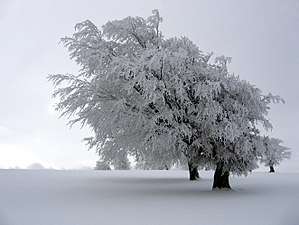Atmospheric icing
Atmospheric icing occurs in the atmosphere when water droplets freeze on objects they come in contact with. Icing conditions can be particularly dangerous to aircraft, as the built-up ice changes the aerodynamics of the flight surfaces, which can increase the risk of a stall. For this reason, on-board ice protection systems have been developed, and aircraft are often deiced prior to take-off in icy environments.

Water does not always freeze at 0 °C (32 °F). Water that persists in liquid state below this temperature is said to be supercooled, and supercooled water droplets cause icing on aircraft. Below −20 °C (−4 °F), icing is rare because clouds at these temperatures usually consist of ice particles rather than supercooled water droplets. Below −48 °C (−54 °F), supercooled water cannot exist, therefore icing is impossible.[1]
Icing also occurs on towers, wind turbines, boats, oil rigs, trees and other objects exposed to low temperatures and water droplets. In cold climates on land, atmospheric icing can be common as elevated terrain interacts with cold clouds.[2] Ice loads are a major cause of catastrophic failures of overhead electric power lines. Their estimation is, therefore, crucial in the structural design of power line systems[3] and can be done by numerical icing models that include meteorological data.[4]
See also
- Condensation
- Frost
- Hard rime
- Soft rime
- Icing (nautical)
References
- Moore, Emily; Valeria Molinero (24 November 2011). "structural transformation in supercooled water controls the crystallization rate of ice". Nature. 479 (7374): 506–508. arXiv:1107.1622. Bibcode:2011Natur.479..506M. doi:10.1038/nature10586. PMID 22113691.
- Yang, Jing; Jones, Kathleen F.; Yu, Wei; Morris, Robert (2012-09-08). "Simulation of in-cloud icing events on Mount Washington with the GEM-LAM". Journal of Geophysical Research: Atmospheres. 117 (D17): n/a. doi:10.1029/2012jd017520. ISSN 0148-0227.
- Farzaneh, M. (2008) Atmospheric Icing of Power Networks. Springer Science & Business Media, 2008, 381 p. ISBN 978-1-4020-8530-7
- Makkonen, L. (2000) Models for the growth of rime, glaze, icicles and wet snow deposits on structures. Philosophical Transactions of the Royal Society, London A, 358 (1776): 2913-2939.
- Sources
- FAA (U.S.) Advisory Circular 20-113: Pilot Precautions and Procedures to be taken in Preventing Aircraft Reciprocating Engine Induction System and Fuel System Icing Problems
- FAA (U.S.) Advisory Circular 20-117: Hazards Following Ground Deicing and Ground Operations in Conditions Conducive to Aircraft Icing
- FAA (U.S.) Advisory Circular 20-147: Turbojet, Turboprop, and Turbofan Engine Induction System Icing and Ice Ingestion
- Wind Energy in Cold Climates: Icing on wind turbines
External links
| Wikimedia Commons has media related to Atmospheric icing. |